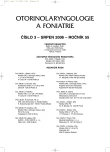Standard and Puncture Dilatation Tracheostomy: Comparison of Results and Complications
Standardní a punkční dilatační tracheostomie Porovnání výsledků a komplikací
Tracheostomie jsou prováděny standardně chirurgicky (ST) nebo punkční dilatační technikou (PDT). Cílem prospektivní randomizované studie bylo porovnat výsledky a komplikace obou technik. Za tříleté období bylo na jednotkách intenzivní péče u kriticky nemocných provedeno 205 elektivních tracheostomií. Do studie byli zařazeni pacienti, kteří splňovali vstupní a výstupní kritéria a k PDT nebo ST byli randomizováni obálkovou metodou. Tracheostomie byly prováděny v analgosedaci a relaxaci, ST modifikovaným stopkatým lalokem podle Björka, PDT technikou podle Griggse. Pacienti obou technik měli shodnou indikaci, věk, pohlaví i délku endotracheální intubace před výkonem. Nebyl nalezen statisticky významný rozdíl v počtu dekanylovaných, v době potřebné k dekanylaci, ani v počtu zemřelých s tracheostomií. Statisticky významný rozdíl byl nalezen v čase provedení tracheostomie (p<0,001), kdy průměrná doba byla u PDT 5,5 min. a ST 15,1min. A v počtu dočasně kanylovaných (p = 0,0131), kdy k datu ukončení studie bylo s PDT 15 a se ST 5 pacientů. Peroperační komplikace byly při PDT v 9 případech (9 %) a po ST v 9 případech (8,6 %). K nejčastější komplikaci patřilo pooperační krvácení, po PDT 17krát a po ST 4krát. Incidence pozdních komplikací byla po PDT ve 2 případech (2 %) a po ST v 7 případech (6,6 %). Nekroptické vyšetření tracheostomie bylo realizováno u 26 zemřelých (8 s PDT, 18 s ST). Nebyl nalezen statistický rozdíl v umístnění tracheostomie na průdušnici, ani ve výskytu mikroskopických změn. Studie prokázala převahu peroperačních a časných pooperačních komplikací u PDT. Pozdní komplikace se častěji vyskytovaly po ST.
Klíčová slova:
standardní chirurgická tracheostomie, punkční dilatační tracheostomie, analýza komplikací.
Authors:
J. Lukáš 1; J. Valvoda 1,2; P. Rambousek 1; prof. MUDr. Jan Bělohlávek, Ph.D. 2; F. Novák 3; Stříteský M. Dušková J. 4 5; T. Haas 6
Authors‘ workplace:
ORL oddělení VFN Praha
; přednosta doc. MUDr. M. Hroboň, CSc.
II. interní klinika 1. LF UK a VFN, Praha
1; přednosta prof. MUDr. M. Aschermann, DrSc.
IV. interní klinika 1. LF UK a VFN Praha
2; přednosta doc. MUDr. A. Žák, CSc.
Klinika anesteziologie a resuscitace 1. LF UK a VFN, Praha
3; přednosta M. Stříteský, CSc.
Ústav patologie 1. LF UK a VFN, Praha
4; přednosta prof. MUDr. C. Povýšil, DrSc.
Ústav biofyziky 1. LF UK a VFN, Praha
5; přednosta doc. Ing. M. Špunda, CSc.
6
Published in:
Otorinolaryngol Foniatr, 55, 2006, No. 3, pp. 144-149.
Category:
Original Article
Overview
To perform analysis of results based on a prospective randomized study and to compare the occurrence of perioperative and postoperative complications in puncture dilatation and standard surgical tracheostomy.
In the period of January 2003 to December 2005, 205 trachemostomies (100 PDT and 105 ST) by endotracheal intubation were performed in critically ill patients at the Intensive Care Units of general Teaching Hospital in Prague. The indication for elective tracheostomy was to secure respiratory pathways in longterm artificial lung ventilation. The study included patients who fulfilled entry and output criteria of the study protocol and were selected for performing PDT or ST by an envelope method. The interventions were performed in analgesic sedation and relaxation, ST was made by a modified stem lobe according to Björk, PDT by the dilatation method according to Griggs using pean forceps (clamp).
In both techniques there was a similar indication for the intervention, as well as age, sex of the patients, and duration of endotracheal intubation. No statistically significant difference was found in the number of decannulated patients (altogether 46%) or in the time period required for decannulation (average time period was 30.3 days in PDTY and 32.2 days in ST), or in the number of deceased patients with tracheostomy (43% altogether) with PDT, which concerned 40 patients with PDT and 47 patients with ST. A statistically significant difference of the time to perform tracheostomy (p < 0.001) was found between PDT (5.5 min) and ST (15.1 min) as well as the number of temporary carriers of tracheostomic cannula (p=0.0131) with PDT (15 patients) and ST (5 patients). The incidence of early postoperative complications was 9% in PDT against 0.9% in ST. The incidence of early postoperative complications was 22% in PDT against 8.6% in ST. Bleeding was the most frequent postoperative complication, which was encountered 17 times in PDT and 4 times in ST. The incidence of late complications was 2% in PDT and 6.6% in ST. Post mortem examination of tracheostomy was performed in 26 deceased patients (8 in PDT and 128 in ST).
There was not any statistically significant difference in the localization of tracheostomy on trachea or in the occurrence of microscopic changes on mucosa.
Our study established the predominance of perioperative and early postoperative complications in PDT. In contrast, late complications occurred more frequently with ST.
Key words:
standard surgical tracheostomy, pucture dilatation analysis of complications.
Labels
Audiology Paediatric ENT ENT (Otorhinolaryngology)Article was published in
Otorhinolaryngology and Phoniatrics

2006 Issue 3
Most read in this issue
- Narrowing of Pharynx and Trachea in Children
- Standard and Puncture Dilatation Tracheostomy: Comparison of Results and Complications
- Is it Important to Evaluate the Size of Adenoid Vegetations?
- A Comparison of Analgesic Efficiency in Patients after Tonsillectomy
